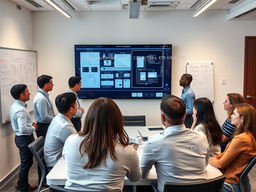Sustainability Starts with Smart AV Design - Is Your AV System Wasting Energy?

Have you ever walked into an empty meeting room where the projector is still running, the lights are on and the audio system hums in the background? Now multiply that scenario across thousands of buildings, events and installations worldwide.
The result? An enormous waste of energy, resources and money !
In today’s world, where sustainability is a global priority, the AV industry has a unique opportunity to make a difference. Smart AV design isn’t just about cutting-edge technology, it’s about creating systems that are energy-efficient, long-lasting and environmentally responsible. From intelligent automation to eco-friendly manufacturing, sustainable AV solutions can significantly reduce waste while enhancing user experience.
So, how can we design smarter AV systems that optimize performance and support a greener future? How Smart AV Design Drives Sustainability ?
- Energy-Efficient AV Systems:
One of the most impactful ways to make AV systems sustainable is through energy efficiency. Modern AV technology now incorporates:
- LED and OLED displays, which consume significantly less power than traditional LCD or plasma screens.
- Smart lighting and audio systems that adjust based on occupancy, ensuring minimal energy waste.
- Energy Star-certified AV equipment, designed for lower power consumption while maintaining high performance.
By integrating these solutions, businesses and venues can significantly cut down on energy use and operational costs.
- Sustainable Materials and Eco-Friendly Manufacturing:
The push for sustainability starts with the materials used in AV hardware. Leading manufacturers are prioritizing:
-Recyclable or biodegradable materials in product enclosures.
-RoHS (Restriction of Hazardous Substances) compliance to reduce toxic components like lead and mercury.
-Modular designs that allow easy repairs and upgrades instead of full replacements, minimizing e-waste.
Choosing AV equipment designed with sustainability in mind ensures a lower environmental impact over the product’s lifetime.
- Smart AV Control and Automation:
Intelligent AV control systems help optimize power consumption and extend equipment lifespan. Features such as:
- Centralized AV management platforms for remote monitoring and automated scheduling.
- Occupancy sensors that adjust power settings when rooms are vacant.
- Cloud-based AV solutions, reducing the need for energy-hungry on-site servers.
By leveraging automation, organizations can prevent unnecessary energy use while maintaining seamless AV experiences.
- Extending Product Lifecycle and Reducing E-Waste:
The AV industry generates significant electronic waste, but smart design choices can help minimize it:
- Investing in high-quality, durable equipment reduces the frequency of replacements.
- Opting for upgradeable systems instead of disposable technology ensures longevity.
- Implementing responsible recycling programs for outdated AV hardware.
Sustainable AV design isn’t just about energy savings—it’s about ensuring that products are built to last and responsibly disposed of when needed.
5. Sustainable AV Design in Action.
Many organizations are already integrating sustainable AV practices into their operations. Green building certifications like LEED (Leadership in Energy and Environmental Design) encourage AV solutions that minimize energy waste and integrate seamlessly with building management systems.
Additionally, AV-as-a-Service (AVaaS) models are gaining traction, ensuring that equipment stays up to date while reducing unnecessary manufacturing and disposal.
Finally ! a question to ask : What is the Future of AV is Sustainability ?
Sustainability in AV goes beyond using greener materials; it’s about designing smarter, more efficient systems that conserve resources and reduce environmental impact.
As the AV industry moves forward, adopting sustainable design principles will be essential in lowering energy consumption, electronic waste and carbon footprints. The question now is:
What steps can you take today to make your AV projects more sustainable?
-
Xchange Advocates are recognized AV/IT industry thought leaders and influencers. We invite you to connect with them and follow their activity across the community as they offer valuable insights and expertise while advocating for and building awareness of the AV industry.
Recommended Content
LetsTalkAVbyAlexis Series: Episode 4 : Design Begins With People: Engineering AV Systems Around Real End-User Requirements

LetsTalkAVbyAlexis Series : Episode 2: Network & AV Convergence (AVoIP)





Please sign in or register for FREE
If you are a registered user on AVIXA Xchange, please sign in